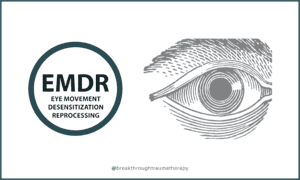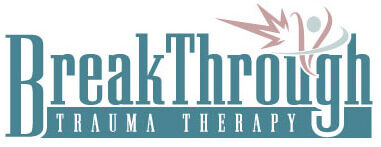Eye movement desensitization and reprocessing (EMDR) is an evidence-based psychotherapy for disorders involving trauma. The intervention uses bilateral stimulation in the form of following the therapist’s moving finger, listening to clicks or tunes in a headphone, or tapping on alternating knees while focusing on a traumatic memory. These core techniques reduce the memory’s intensity, distress, and vividness and promote the development of positive thoughts and feelings about the experience.
EMDR is still a relatively new psychotherapy, first introduced in the 80s. Its theoretical foundation is the Adaptive Information Processing (AIP) model, which explains how the brain processes information, particularly concerning traumatic or disturbing experiences.
The Adaptive Information Processing Model
The AIP model explains how the hippocampus, the part of the brain that processes and integrates experiences into memories during a traumatic experience. The hippocampus encodes new information from your experiences into short-term memory in a process known as encoding. It also transforms short-term memory into long-term memory through a process known as consolidation. Aside from storing memories, the hippocampus also integrates them within their context, incorporating the emotions, sensations, and surrounding details linked to the experience.
The hippocampus does not function in isolation. Like all brain regions, it collaborates with other parts to execute complex tasks. In forming and retrieving memories, the hippocampus interacts with the prefrontal cortex, responsible for emotion processing, decision-making, and retrieval strategies. It also works with the amygdala, the stress response center involved in processing distressing sensations.
In healthy or adaptive circumstances, the hippocampus, amygdala, and prefrontal cortex integrate experiences with existing memory networks, leading to a comprehensive understanding and emotional resolution. However, the process can become disrupted during intensely stressful or traumatic experiences due to overstimulation, resulting in incomplete or dysfunctional processing of the traumatic event.
The AIP model posits that inadequately processed memories become encapsulated in isolated memory networks, disconnected from other memory networks. This isolation hinders a person’s capacity to integrate the traumatic experience and develop an overall understanding of themselves and the world, leading to associated psychological symptoms such as flashbacks, nightmares, and emotional distress.
How EMDR Works

Bilateral stimulation through eye movements, tapping, or sounds facilitates the reprocessing of isolated memories by stimulating the brain. It promotes the integration of the traumatic memory into a more adaptive and healthy network, reducing trauma symptoms significantly.
How is EMDR Different From Talk Therapy?
Primary Focus
Every psychotherapy employs specific techniques that target trauma-related disorders from different angles. Most treatments, especially talk therapy, focus on directly altering the emotions, thoughts, and responses associated with the trauma.
The intensity of a traumatic experience leaves the amygdala, hippocampus, and prefrontal cortex hypersensitive to the traumatic experience. The amygdala remains constantly alert, picking and processing phantom sensations from all body senses. It then sends signals to the hippocampus, which retrieves a fragmented memory containing disjointed information on the associated emotions, thoughts, and experiences.
The retrieved memory invokes an intense, persistent, uncontrollable response owing to the vividness of its manifestation, enough to disrupt daily living. Furthermore, its magnitude is worsened by the exaggerated emotional response from the prefrontal cortex, presenting the memory as an imminent threat.
Talk therapy employs strategies to recognize triggers related to traumatic memories, regulate emotions and thoughts, and address the root cause of the trauma. The counseling psychologist guides you to:
● Learn to identify and manage stressors, which activate the amygdala.
● Regulate the resulting emotional response through mindfulness, relaxation techniques, and emotional validation.
● Identify the cause of your trauma.
● Piece the missing links in your fragmented memory.
● Develop resilience over triggers, memories, and thoughts.
● Regulate your thoughts through rationalization and cognitive reframing.
On the other hand, EMDR therapy focuses directly on the memory, aiming to reprocess the faulty memory stored in the brain, which, in turn, diminishes the intensity and eventually eliminates the problematic symptoms.
Therapeutic Approach
As the name suggests, talk therapy uses verbal expression to process trauma. By talking through your past experiences and current struggles, you gain insights into why you think, act, and react to certain situations in a maladaptive manner. The therapist guides the talk, noting down patterns and providing techniques to reframe the narrative and shift perspectives regarding the trauma, reducing its emotional impact. While talk therapy can be emotionally taxing, as you have to relieve the experience in detail, it occurs in a safe space under a professional support and accountability system.
EMDR prioritizes addressing the present and future by targeting negative emotions and beliefs associated with the trauma without requiring detailed discussion of specific traumatic details. This approach acknowledges the past while focusing on reprocessing the emotional and physiological impact of the trauma. Bilateral stimulation facilitates the processing and integration of the traumatic experience. By avoiding extensive re-description, EMDR can be a less emotionally taxing approach for individuals who find detailed recounting difficult.
Techniques
Talk therapy employs diverse techniques for specific purposes. The therapist determines which techniques to use on a case basis. Cognitive restructuring identifies and challenges negative or disruptive thought patterns associated with trauma.
Exposure therapy gradually exposes you to safe and controlled versions of your fears or anxiety triggers to build resilience. You also learn adaptive coping mechanisms to help you deal with the traumatic experience in real-time. Interpersonal therapy enhances communication and relationship skills, enabling you to recognize and rectify dysfunctional patterns when interacting with others. Conversely, EMDR relies on bilateral stimulation to facilitate the desensitization and reprocessing of traumatic memories by stimulating the brain's natural information processing system.
Insight Vs. Reprocessing
Talk therapy emphasizes gaining insight into the underlying reasons behind thoughts, emotions, and behaviors relating to the trauma. It involves exploring the past, uncovering the origins of negative patterns, and understanding the "why" behind them. This exploration develops your cognitive understanding and self-awareness, making it easier to learn positive coping mechanisms and challenge maladaptive thoughts and emotions.
In contrast, EMDR therapy focuses on reprocessing the emotional and physiological impact of past experiences without necessarily requiring total intellectual understanding. It aims to desensitize and integrate the traumatic memory, reducing its emotional charge.
Therapy Duration
Talk therapy can last a long time because it goes beyond past traumatic experiences into present and future incidences. It can last for months or even years. EMDR therapy typically consists of 6-12 brief sessions, conducted one to two times per week, with the possibility of consecutive sessions. Many individuals experience relief within a few weeks or months of treatment.
Suitability
The various techniques utilized in talk therapy make it suitable for treating a wide range of mental health concerns, from anxiety and mood disorders to personality disorders, relationship issues, and stress management. EMDR is primarily effective for treating and managing trauma-related conditions like PTSD and complex trauma. Its efficiency in treating other mental illnesses is still in research.
Neuroscience Principles
EDMR draws its foundation on the principle that traumatic experiences become stuck in the brain’s processing system, creating a never-ending loop of psychological and emotional distress. By utilizing bilateral stimulation and directing attention to a particular traumatic memory, it becomes possible to reprocess the memory network, transforming it into a healthy and adaptive memory.
Talk therapy primarily focuses on the cognitive (thoughts) and behavioral (actions) aspects of trauma-related conditions. The therapist guides you to identify and challenge negative thoughts and emotional patterns, develop adaptive coping mechanisms, and learn behaviors that promote healthier choices.
Comfortability
Recalling traumatic experiences ignites a whirlwind of emotions, from fear and shame to anger and sorrow, potentially leading to re-traumatization. EMDR is a great therapeutic option for people who find it challenging to vocalize their trauma. It circumvents extensive verbal recounting, honing in on singular memories per session. The therapist helps dismantle the sensory, emotional, and adverse perceptions tied to the memory and uses bilateral stimulation to steer gently toward specific facets of the memory.
Outcome
Both Talk therapy and EMDR are effective approaches for treating trauma-related mental conditions based on evidence published in research. Nevertheless, the talk therapy techniques used impact treatment duration. Talk therapy can also include medication to increase responsiveness to treatment. EMDR relies solely on bilateral stimulation and focusing on a specific trauma memory. Results from this therapy can occur before the sessions are over for some patients.
The Best Treatment For Trauma
Mental conditions manifest differently in everyone. Counseling psychologists tailor treatment on a case-by-case basis. Therefore, the best intervention is the one curated by your therapist because it is the most suitable for your case. Your therapist carefully considers various aspects of your condition before customizing a plan. They may also opt to integrate multiple approaches simultaneously to enhance your overall outcome.
Seek A Therapist Today
The journey to recovering from the mental and physical distress inflicted by traumatic memories begins with psychotherapy. You do not have to bear the burden of intrusive thoughts, memories, emotions, nightmares, and flashbacks. Without any intervention, your mental health continues to decline, pushing you toward destructive behaviors to cope. You can find relief by seeking the services of a counseling psychologist. Start today. Consult a therapist near you.
Contact Us
